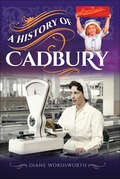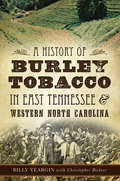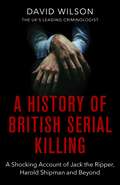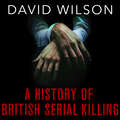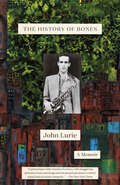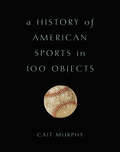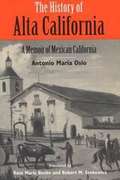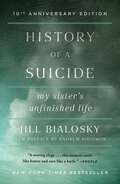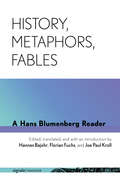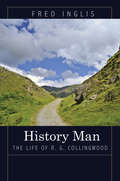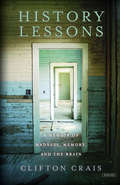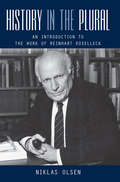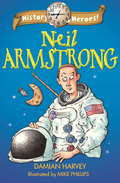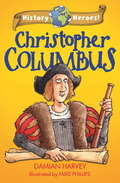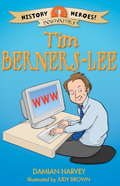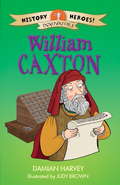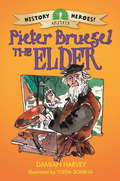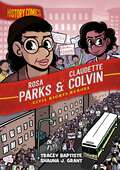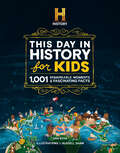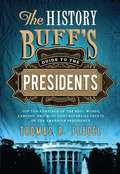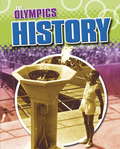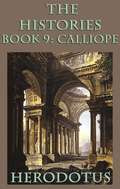- Table View
- List View
A History of Cadbury
by Diane WordsworthWhen John Cadbury came to Birmingham in 1824, he sold tea, coffee and drinking chocolate in a small shop on Bull Street. Drinking chocolate was considered a healthy alternative to alcohol, something Cadbury, a Quaker, was keen to encourage.In 1879, the Cadburys moved to Bournville and created their factory in a garden an unprecedented move. It is now ironic that todays Bournville is surrounded by that urban sprawl the Cadburys were so keen to get away from.This book looks at some of the social impact this company has had since its inception, both on the chocolate and cocoa business in general and on the community at large, both within and without the firm of Cadbury.In 2024, Cadbury's will be celebrating 200 years of the first store opening. This is the story of how the company began, how it grew, and how they diversified in order to survive.
A History of Burley Tobacco in East Tennessee & Western North Carolina
by Billy Yeargin Christopher BickersBurley tobacco revolutionized the industry in east Tennessee and western North Carolina. What started from two farmers planting white burley in Greeneville ignited an agricultural revolution and significantly changed crops, production and quality. Burley transformed the tobacco industry with new cultivation techniques and a shift from dark and flue-cured tobacco. By the 1990s, burley tobacco production in the region had drastically declined, and it is a tradition that few local farmers still practice. Agricultural experts Billy Yeargin and Christopher Bickers take a nostalgic look at the historic rise of burley tobacco and its gradual decline.
A History Of British Serial Killing: The Shocking Account of Jack the Ripper, Harold Shipman and Beyond
by David WilsonBE THE FIRST TO READ DAVID WILSON'S NEW TRUE CRIME BOOK "A PLOT TO KILL" BY PRE-ORDERING NOW Expanded and updated, this is the definitive history of British serial killing 1888-2020 - by the UK's leading criminologist, David WilsonIn this fascinating and informative book, Professor David Wilson tells the stories of Britain's serial killers from Jack the Ripper to the extraordinary Suffolk Murders case. David Wilson has worked as a Prison Governor and as a profiler, and has been described as the UK's leading expert on serial killers. His work has led him to meet several of the UK's deadliest killers, and build up fascinating insights into what makes a serial killer - and who they are most likely to target. A vivid narrative history and a call for prison and social reform, Professor Wilson's new book is a powerful and gripping investigation of Britain's serial murderers.
A History Of British Serial Killing: The Shocking Account of Jack the Ripper, Harold Shipman and Beyond (The Books of Babel)
by David WilsonBE THE FIRST TO READ DAVID WILSON'S NEW TRUE CRIME BOOK "A PLOT TO KILL" BY PRE-ORDERING NOW Expanded and updated, this is the definitive history of British serial killing 1888-2020 - by the UK's leading criminologist, David WilsonIn this fascinating and informative book, Professor David Wilson tells the stories of Britain's serial killers from Jack the Ripper to the extraordinary Suffolk Murders case. David Wilson has worked as a Prison Governor and as a profiler, and has been described as the UK's leading expert on serial killers. His work has led him to meet several of the UK's deadliest killers, and build up fascinating insights into what makes a serial killer - and who they are most likely to target. A vivid narrative history and a call for prison and social reform, Professor Wilson's new book is a powerful and gripping investigation of Britain's serial murderers.
The History of Bones: A Memoir
by John LurieThe quintessential depiction of 1980s New York and the downtown scene from the artist, actor, musician, and composer John Lurie&“Ferocious and wise, funny and tragic, raging and forgiving, and I loved every page.&”—Nick Flynn, author of Another Bullshit Night in Suck CityIn the tornado that was downtown New York in the 1980s, John Lurie stood at the vortex. After founding the band The Lounge Lizards with his brother, Evan, in 1979, Lurie quickly became a centrifugal figure in the world of outsider artists, cutting-edge filmmakers, and cultural rebels. Now Lurie vibrantly brings to life the whole wash of 1980s New York as he developed his artistic soul over the course of the decade and came into orbit with all the prominent artists of that time and place, including Andy Warhol, Debbie Harry, Boris Policeband, and, especially, Jean-Michel Basquiat, the enigmatic prodigy who spent a year sleeping on the floor of Lurie&’s East Third Street apartment. It may feel like Disney World now, but in The History of Bones, the East Village, through Lurie&’s clear-eyed reminiscence, comes to teeming, gritty life. The book is full of grime and frank humor—Lurie holds nothing back in this journey to one of the most significant moments in our cultural history, one whose reverberations are still strongly felt today. History may repeat itself, but the way downtown New York happened in the 1980s will never happen again. Luckily, through this beautiful memoir, we all have a front-row seat.
A History of American Sports in 100 Objects
by Cait MurphyBeautifully designed and carefully curated, a fascinating collection of the things that shaped the way we live and play in AmericaWhat artifact best captures the spirit of American sports? The bat Babe Ruth used to hit his allegedly called shot, or the ball on which Pete Rose wrote, "I'm sorry I bet on baseball"? Could it be Lance Armstrong's red-white-and-blue bike, now tarnished by doping and hubris? Or perhaps its ancestor, the nineteenth-century safety bicycle that opened an avenue of previously unknown freedom to women? The jerseys of rivals Larry Bird and Magic Johnson? Or the handball that Abraham Lincoln threw against a wall as he waited for news of his presidential nomination?From nearly forgotten heroes like Tad Lucas (rodeo) and Tommy Kono (weightlifting) to celebrities like Amelia Earhart, Muhammad Ali, and Michael Phelps, Cait Murphy tells the stories of the people, events, and things that have forged the epic of American sports, in both its splendor and its squalor. Stories of heroism and triumph rub up against tales of discrimination and cheating. These objects tell much more than just stories about great games-they tell the story of the nation. Eye-opening and exuberant, A History of American Sports in 100 Objects shows how the games Americans play are woven into the gloriously infuriating fabric of America itself.
The History of Alta California
by Antonio María OsioAntonio María Osio’s La Historia de Alta California was the first written history of upper California during the era of Mexican rule, and this is its first complete English translation. A Mexican-Californian, government official, and the landowner of Angel Island and Point Reyes, Osio writes colorfully of life in old Monterey, Los Angeles, and San Francisco, and gives a first-hand account of the political intrigues of the 1830s that led to the appointment of Juan Bautista Alvarado as governor. Osio wrote his History in 1851, conveying with immediacy and detail the years of the U.S.-Mexican War of 1846–1848 and the social upheaval that followed. As he witnesses California’s territorial transition from Mexico to the United States, he recalls with pride the achievements of Mexican California in earlier decades and writes critically of the onset of U.S. influence and imperialism. Unable to endure life as foreigners in their home of twenty-seven years, Osio and his family left Alta California for Mexico in 1852. Osio’s account predates by a quarter century the better-known reminiscences of Mariano Guadalupe Vallejo and Juan Bautista Alvarado and the memoirs of Californios dictated to Hubert Howe Bancroft’s staff in the 1870s. Editors Rose Marie Beebe and Robert M. Senkewicz have provided an accurate, complete translation of Osio’s original manuscript, and their helpful introduction and notes offer further details of Osio’s life and of society in Alta California.
History of a Suicide: My Sister's Unfinished Life
by Jill Bialosky"It is so nice to be happy. It always gives me a good feeling to see other people happy. . . . It is so easy to achieve." --Kim's journal entry, May 3, 1988 On the night of April 15, 1990, Jill Bialosky's twenty-one-year-old sister Kim came home from a bar in downtown Cleveland. She argued with her boyfriend on the phone. Then she took her mother's car keys, went into the garage, closed the garage door. She climbed into the car, turned on the ignition, and fell asleep. Her body was found the next morning by the neighborhood boy her mother hired to cut the grass. Those are the simple facts, but the act of suicide is anything but simple. For twenty years, Bialosky has lived with the grief, guilt, questions, and confusion unleashed by Kim's suicide. Now, in a remarkable work of literary nonfiction, she re-creates with unsparing honesty her sister's inner life, the events and emotions that led her to take her life on this particular night. In doing so, she opens a window on the nature of suicide itself, our own reactions and responses to it--especially the impact a suicide has on those who remain behind. Combining Kim's diaries with family history and memoir, drawing on the works of doctors and psychologists as well as writers from Melville and Dickinson to Sylvia Plath and Wallace Stevens, Bialosky gives us a stunning exploration of human fragility and strength. She juxtaposes the story of Kim's death with the challenges of becoming a mother and her own exuberant experience of raising a son. This is a book that explores all aspects of our familial relationships--between mothers and sons, fathers and daughters--but particularly the tender and enduring bonds between sisters. History of a Suicide brings a crucial and all too rarely discussed subject out of the shadows, and in doing so gives readers the courage to face their own losses, no matter what those may be. This searing and compassionate work reminds us of the preciousness of life and of the ways in which those we love are inextricably bound to us.
History, Metaphors, Fables: A Hans Blumenberg Reader (signale|TRANSFER: German Thought in Translation)
by Hans BlumenbergHistory, Metaphors, and Fables collects the central writings by Hans Blumenberg and covers topics such as on the philosophy of language, metaphor theory, non-conceptuality, aesthetics, politics, and literary studies. This landmark volume demonstrates Blumenberg's intellectual breadth and gives an overview of his thematic and stylistic range over four decades. Blumenberg's early philosophy of technology becomes tangible, as does his critique of linguistic perfectibility and conceptual thought, his theory of history as successive concepts of reality", his anthropology, or his studies of literature. History, Metaphors, Fables allows readers to discover a master thinker whose role in the German intellectual post-war scene can hardly be overestimated.
History Man: The Life of R. G. Collingwood
by Fred InglisThis is the first biography of the last and greatest British idealist philosopher, R. G. Collingwood (1889-1943), a man who both thought and lived at full pitch. Best known today for his philosophies of history and art, Collingwood was also a historian, archaeologist, sailor, artist, and musician. A figure of enormous energy and ambition, he took as his subject nothing less than the whole of human endeavor, and he lived in the same way, seeking to experience the complete range of human passion. In this vivid and swiftly paced narrative, Fred Inglis tells the dramatic story of a remarkable life, from Collingwood's happy Lakeland childhood to his successes at Oxford, his archaeological digs as a renowned authority on Roman Britain, his solo sailing adventures in the English Channel, his long struggle with illness, and his sometimes turbulent romantic life. In a manner unheard of today, Collingwood attempted to gather all aspects of human thought into a single theory of practical experience, and he wrote sweeping accounts of history, art, science, politics, metaphysics, and archaeology, as well as a highly regarded autobiography. Above all, he dedicated his life to arguing that history--not science--is the only source of moral and political wisdom and self-knowledge. Linking the intellectual and personal sides of Collingwood's life, and providing a rich history of his milieu, History Man also assesses Collingwood's influence on generations of scholars after his death and the renewed recognition of his importance and interest today.
History Lessons: A Memoir of Madness, Memory, and the Brain
by Clifton CraisBorn in Louisiana to a soon-to-be absent father and an alcoholic mother--who tried to drown him in a bathtub when he was three--Clifton Crais spent his childhood perched beside his mother on a too-tall bar stool, living with relatives too old or infirmed to care for him, or rambling on his own through New Orleans, a city both haunted and created by memory. Indeed, it is memory--both elusive and essential--that forms the center of Crais's beautifully rendered memoir History Lessons. In an effort to restore his own, Crais brings the tools of his formal training as a historian to bear on himself and his family. He interviews his sisters and his mother, revisits childhood homes and pores over documentary evidence: plane tickets, postmarks, court and medical records, crumbling photo albums. Probing family lore, pushing past silences and exhuming long-buried family secrets, he arrives, ultimately, at the deepest reaches of the brain. Crais examines the science of memory and forgetting, from the ways in which experience shapes the developing brain to the mechanisms that cause the chronic childhood amnesia--the most common and least understood form of amnesia--from which he suffers. Part memoir, part narrative science and part historical detective story, History Lessons is a provocative, exquisitely crafted investigation into what it means to be human.
History Lessons: A Memoir of Madness, Memory, and the Brain
by Clifton CraisBorn in Louisiana to a soon-to-be absent father and an alcoholic mother—who tried to drown him in a bathtub when he was three—Clifton Crais spent his childhood perched beside his mother on a too-tall bar stool, living with relatives too old or infirmed to care for him, or rambling on his own through New Orleans, a city both haunted and created by memory. Indeed, it is memory—both elusive and essential—that forms the center of Crais’s beautifully rendered memoir History Lessons. In an effort to restore his own, Crais brings the tools of his formal training as a historian to bear on himself and his family. He interviews his sisters and his mother, revisits childhood homes and pores over documentary evidence: plane tickets, postmarks, court and medical records, crumbling photo albums. Probing family lore, pushing past silences and exhuming long-buried family secrets, he arrives, ultimately, at the deepest reaches of the brain. Crais examines the science of memory and forgetting, from the ways in which experience shapes the developing brain to the mechanisms that cause the chronic childhood amnesia—the most common and least understood form of amnesia—from which he suffers. Part memoir, part narrative science and part historical detective story, History Lessons is a provocative, exquisitely crafted investigation into what it means to be human.
History Lessons
by Clifton CraisBorn in Louisiana to a soon-to-be absent father and an alcoholic mother--who tried to drown him in a bathtub when he was three--Clifton Crais spent his childhood perched beside his mother on a too-tall bar stool, living with relatives too old or infirmed to care for him, or rambling on his own through New Orleans, a city both haunted and created by memory. Indeed, it is memory--both elusive and essential--that forms the center of Crais's beautifully rendered memoir History Lessons. In an effort to restore his own, Crais brings the tools of his formal training as a historian to bear on himself and his family. He interviews his sisters and his mother, revisits childhood homes and pores over documentary evidence: plane tickets, postmarks, court and medical records, crumbling photo albums. Probing family lore, pushing past silences and exhuming long-buried family secrets, he arrives, ultimately, at the deepest reaches of the brain. Crais examines the science of memory and forgetting, from the ways in which experience shapes the developing brain to the mechanisms that cause the chronic childhood amnesia--the most common and least understood form of amnesia--from which he suffers. Part memoir, part narrative science and part historical detective story, History Lessons is a provocative, exquisitely crafted investigation into what it means to be human.
History In The Plural
by Niklas OlsenReinhart Koselleck (1923-2006) was one of most imposing and influential European intellectual historians in the twentieth century. Constantly probing and transgressing the boundaries of mainstream historical writing, he created numerous highly innovative approaches, absorbing influences from other academic disciplines as represented in the work of philosophers and political thinkers like Hans Georg Gadamer and Carl Schmitt and that of internationally renowned scholars such as Hayden White, Michel Foucault, and Quentin Skinner. An advocate of "grand theory," Koselleck was an inspiration to many scholars and helped move the discipline into new directions (such as conceptual history, theories of historical times and memory) and across disciplinary and national boundaries. He thus achieved a degree of international fame that was unusual for a German historian after 1945. This book not only presents the life and work of a "great thinker" and European intellectual, it also contributes to our understanding of complex theoretical and methodological issues in the cultural sciences and to our knowledge of the history of political, historical, and cultural thought in Germany from the 1950s to the present.
History Heroes: Neil Armstrong
by Damian HarveyNeil Armstrong was involved in one of the most memorable events of the twentieth century - the moon landing! Find out more about how he got to become one of the first to set foot on the moon. Discover the stories of people who have helped to shape history, ranging from early explorers such as Christopher Columbus to more modern figures like Tim Berners-Lee, inventor of the World Wide Web. These chapter books combine historical fact with engaging narrative and humourous illustration, perfect for the newly independent reader.
History Heroes: Christopher Columbus
by Damian HarveyChristopher Columbus sailed the seas in search of the perfect trade route - find out how his life and explorations helped to change the world! Discover the stories of people who have helped to shape history, ranging from early explorers such as Christopher Columbus to more modern figures like Tim Berners-Lee, inventor of the World Wide Web. These chapter books combine historical fact with engaging narrative and humourous illustration, perfect for the newly independent reader.
History Heroes: Tim Berners-Lee
by Damian Harvey Judy BrownTim Berners Lee started off his career building computers out of old televisions. He is now one of the most prolific internet experts in the world and was responsible for founding the World Wide Web! Discover the stories of people who have helped to shape history, ranging from early explorers such as Christopher Columbus to more modern figures like Tim Berners-Lee, inventor of the World Wide Web. These chapter books combine historical fact with engaging narrative and humourous illustration, perfect for the newly independent reader.
History Heroes: William Caxton
by Damian Harvey Judy BrownWilliam Caxton led the way in bringing the printing press to the English and made books accessible to many people. Discover the stories of people who have helped to shape history, ranging from early explorers such as Christopher Columbus to more modern figures like Tim Berners-Lee, inventor of the World Wide Web. These chapter books combine historical fact with engaging narrative and humourous illustration, perfect for the newly independent reader.
History Heroes: Pieter Bruegel the Elder
by Damian Harvey Yulyia SominaPieter Bruegel, the greatest Flemmish painter of the 16th Century, developed a unique style of painting and created many masterpieces, often painting scenes of daily life. Discover the stories of people who have helped to shape history, ranging from early explorers such as Christopher Columbus to more modern figures like Tim Berners-Lee, inventor of the World Wide Web. These chapter books combine historical fact with engaging narrative and humourous illustration, perfect for the newly independent reader.
History Comics: Civil Rights Heroes (History Comics)
by Tracey BaptisteTurn back the clock with History Comics! In this volume, learn about two brave women who stood up against segregation, setting in motion the Montgomery Bus Boycott!A Black woman who refused to give up her seat on a segregated bus sparked a bus boycott and became part of one of the most iconic moments in American history. Yet, few know that Rosa Parks had actively worked toward social justice her whole life. And even fewer know that the seeds of the statewide bus boycott were first planted by a teenager named Claudette Colvin, who was arrested on similar charges months earlier. Rosa Parks and Claudette Colvin inspired a nation, showing how positive change can start with a single defiant act. Their actions have become the stuff of legend, but there is so much more to their lives, their stories, and the movement they began.
The HISTORY Channel This Day in History For Kids: 1001 Remarkable Moments and Fascinating Facts
by Dan BovaAn exciting, visual adventure through history with day-by-day accounts of extraordinary events, notable people, and incredible inventions for kids ages 8-12.History comes alive in this beautifully illustrated book with bite-size facts (along with a touch of humor) that will engage and entertain young curious minds. Jam-packed with important events, inspiring accomplishments by remarkable people, and groundbreaking inventions, this super-fun fact-filled book, the first kids book from History Channel, includes the most interesting historical facts--from early civilization up to the 21st century all around the world for every day of the year. Each day&’s entry includes multiple events that occurred on that day in history along with charming original illustrations and photography. Plus, readers are prompted to recall their own remarkable milestones, helping them to consider their place in history. Inside, kids will discover:Historic events that happened on their birthdayMajor moments in sportsGroundbreaking events and famous military battlesFearless explorers, inventors and freedom fightersRecord-breaking stuntsWeird and wacky holidaysIncredible dinosaur discoveries, and much more!A great gift for an up-and-coming history buff and an engaging resource for the classroom, this book offers a fresh twist on history, looking into the past and letting you recall your own.
The History Buff's Guide to the Presidents
by Thomas R. FlagelAmericans have named schools, counties, rivers, cities, and even their own children after U. S. presidents. Their work is in our laws, their words adorn our monuments, and their countenances appear in a trillion places (mostly on our currency). As we prepare to decide who will be the 44th president of the United States, can we truly say we understand the office and its phenomenal history? What do we really know about the men who helped transform a struggling republic into a superpower?Using detailed top-ten lists, historian Thomas R. Flagel offers a provocative new look at an astonishingly resilient institution. With diligent research, he explores the best, worst, largest, and most controversial facets of an office that some feared would become a monarchy, others hoped would represent all of the people, and John Adams wanted to call "High Highness, the President of the United States of America, and the Protector of their Liberties. "Chapters include: - Elections: the closest races, the most vicious campaigns, and the biggest landslidesPresidential Character: careers, hobbies, the most religious presidents, and the Machiavellians - The Domestic Sphere: the biggest deficit spenders, the most ambitious programs, vetoes, pardons, and the worst fights with the Superme Courts - Foreign Affairs: diplomats, doctrines, and ranking the commanders in chief - The Inner Circle: first ladies and vexing relatives, construction and destruction in the White House, scandals at the highest level, and the real West WingI - n Retrospect: the most underrated and overrated presidents, assassinations and attempted assassinations, and the greatest changes to the presidency itself
History
by Moira ButterfieldEach title of The Olympics examines the the Olympic Games from ancient times, then the revival of the 1890s through to today's multi-million pound business. From the history of the games to which events are included and why, and from scandals to record breakers, The Olympics puts the reader at the centre of the action with fact-packed text, dramatic full-colour photos, facts and statistics.
History (The Olympics #3)
by Moira ButterfieldEach title of The Olympics examines the the Olympic Games from ancient times, then the revival of the 1890s through to today's multi-million pound business. From the history of the games to which events are included and why, and from scandals to record breakers, The Olympics puts the reader at the centre of the action with fact-packed text, dramatic full-colour photos, facts and statistics.
The Histories Book 9: Calliope
by HerodotusHerodotus was an ancient Greek historian who lived in the fifth century BC (c.484 - 425 BC). He has been called the "Father of History", and was the first historian known to collect his materials systematically, test their accuracy to a certain extent and arrange them in a well-constructed and vivid narrative. The Histories-his masterpiece and the only work he is known to have produced-is a record of his "inquiry", being an investigation of the origins of the Greco-Persian Wars and including a wealth of geographical and ethnographical information. The Histories, were divided into nine books, named after the nine Muses: the "Muse of History", Clio, representing the first book, then Euterpe, Thaleia, Melpomene, Terpsichore, Erato, Polymnia, Ourania and Calliope for books 2 to 9, respectively.
